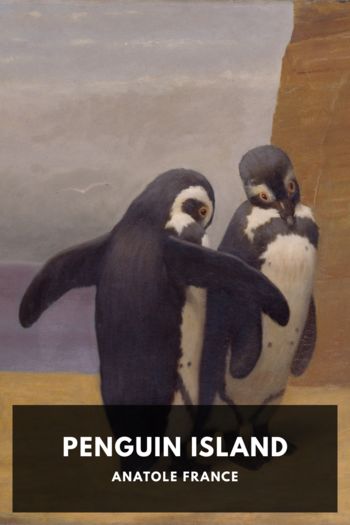Penguin Island Anatole France (speed reading book .txt) 📖

- Author: Anatole France
Book online «Penguin Island Anatole France (speed reading book .txt) 📖». Author Anatole France
I picture to myself the Penguin primitives in conformity with the works of that master. It will not therefore be thought superfluous if in this place I consider his works with some attention, if not in detail, at least under their more general and, if I dare say so, most representative aspect.
We possess five or six pictures signed with his hand. His masterpiece, preserved in the National Gallery of London, represents the Virgin seated on a throne and holding the infant Jesus in her arms. What strikes one first when one looks at this figure is the proportion. The body from the neck to the feet is only twice as long as the head, so that it appears extremely short and podgy. This work is not less remarkable for its painting than for its drawing. The great Margaritone had but a limited number of colours in his possession, and he used them in all their purity without ever modifying the tones. From this it follows that his colouring has more vivacity than harmony. The cheeks of the Virgin and those of the Child are of a bright vermilion which the old master, from a naive preference for clear definitions, has placed on each face in two circumferences as exact as if they had been traced out by a pair of compasses.
A learned critic of the eighteenth century, the Abbé Lanzi, has treated Margaritone’s works with profound disdain. “They are,” he says, “merely crude daubs. In those unfortunate times people could neither draw nor paint.” Such was the common opinion of the connoisseurs of the days of powdered wigs. But the great Margaritone and his contemporaries were soon to be avenged for this cruel contempt. There was born in the nineteenth century, in the biblical villages and reformed cottages of pious England, a multitude of little Samuels and little St. Johns, with hair curling like lambs, who, about 1840, and 1850, became spectacled professors and founded the cult of the primitives.
That eminent theorist of Pre-Raphaelitism, Sir James Tuckett, does not shrink from placing the Madonna of the National Gallery on a level with the masterpieces of Christian art. “By giving to the Virgin’s head,” says Sir James Tuckett, “a third of the total height of the figure, the old master attracts the spectator’s attention and keeps it directed towards the more sublime parts of the human figure, and in particular the eyes, which we ordinarily describe as the spiritual organs. In this picture, colouring and design conspire to produce an ideal and mystical impression. The vermilion of the cheeks does not recall the natural appearance of the skin; it rather seems as if the old master has applied the roses of Paradise to the faces of the Mother and the Child.”
We see, in such a criticism as this, a shining reflection, so to speak, of the work which it exalts; yet MacSilly, the seraphic aesthete of Edinburgh, has expressed in a still more moving and penetrating fashion the impression produced upon his mind by the sight of this primitive painting. “The Madonna of Margaritone,” says the revered MacSilly, “attains the transcendent end of art. It inspires its beholders with feelings of innocence and purity; it makes them like little children. And so true is this, that at the age of sixty-six, after having had the joy of contemplating it closely for three hours, I felt myself suddenly transformed into a little child. While my cab was taking me through Trafalgar Square I kept laughing and prattling and shaking my spectacle-case as if it were a rattle. And when the maid in my boardinghouse had served my meal I kept pouring spoonfuls of soup into my ear with all the artlessness of childhood.”
“It is by such results,” adds MacSilly, “that the excellence of a work of art is proved.”
Margaritone, according to Vasari, died at the age of seventy-seven, “regretting that he had lived to see a new form of art arising and the new artists crowned with fame.”
These lines, which I translate literally, have inspired Sir James Tuckett with what are perhaps the finest pages in his work. They form part of his Breviary for Aesthetes; all the Pre-Raphaelites know them by heart. I place them here as the most precious ornament of this book. You will agree that nothing more sublime has been written since the days of the Hebrew prophets.
Margaritone’s VisionMargaritone, full of years and labours, went one day to visit the studio of a young painter who had lately settled in the town. He noticed in the studio a freshly painted Madonna, which, although severe and rigid, nevertheless, by a certain exactness in the proportions and a devilish mingling of light and shade, assumed an appearance of relief and life. At this sight the artless and sublime worker of Arezzo perceived with horror what the future of painting would be. With his brow clasped in his hands he exclaimed:
“What things of shame does not this figure show forth! I discern in it the end of that Christian art which paints the soul and inspires the beholder with an ardent desire for heaven. Future painters will not restrain themselves as does this one to portraying on the side of a wall or on a wooden panel the cursed matter of which our bodies are formed;





Comments (0)